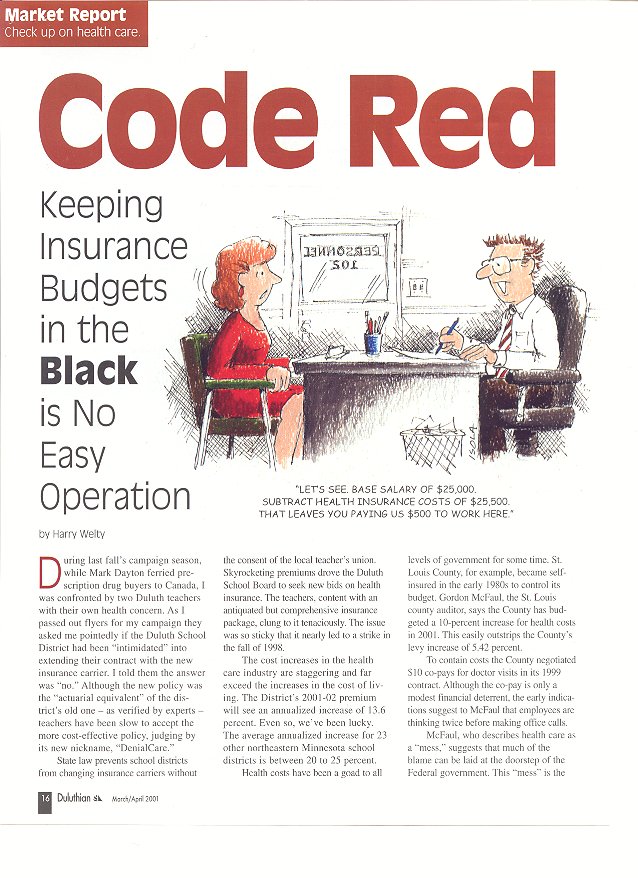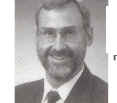The Chamber of Commerce asked me to write a column at the end of 2000. This is
their final edit of my story. Full text below.

During last fall's campaign season, while Mark Dayton ferried prescription drug buyers to Canada, I was confronted by two Duluth teachers with their own health concern. As I passed out flyers for my campaign they asked me pointedly if the Duluth School District had been "intimidated" into extending their contract with the new insurance carrier. I told them the answer was "no." Although the new policy was the "actuarial equivalent" of the district's old one - as verified by experts teachers have been slow to accept the more cost-effective policy, judging by its new nickname, "DenialCare."
State law prevents school districts from changing insurance carriers without the consent of the local teacher's union. Skyrocketing premiums drove the Duluth School Board to seek new bids on health insurance. The teachers, content with an antiquated but comprehensive insurance package, clung to it tenaciously. The issue was so sticky that it nearly led to a strike in the fall of 1998.
The cost increases in the health care industry are staggering and far exceed the increases in the cost of living. The District's 2001-02 premium will see an annualized increase of 13.6 percent. Even so, we've been lucky. The average annualized increase for 23 other northeastern Minnesota school districts is between 20 to 25 percent.
Health costs have been a goad to all levels of government for some time. St. Louis County, for example, became selfinsured in the early 1980s to control its budget. Gordon McFaul, the St. Louis county auditor, says the County has budgeted a 10-percent increase for health costs in 2001. This easily outstrips the County's levy increase of 5.42 percent.
To contain costs the County negotiated $10 co-pays for doctor visits in its 1999 contract. Although the co-pay is only a modest financial deterrent, the early indications suggest to McFaul that employees are thinking twice before making office calls.
McFaul, who describes health care as a "mess," suggests that much of the blame can be laid at the doorstep of the Federal government. This "mess" is the
plight facing most hospitals according to Shireen Gandhi-Kozel, assistant vice president for the Minnesota Hospital Healthcare Partnership.
Gandhi-Kozel pointed to a study that showed managed care operations give Minnesota hospitals an average of 97.7 cents for every dollar spent for hospital treatment. The State and Federal government are even stingier. Minnesota Care only paid 94 cents on the dollar and the Federal government only gave 93 cents on the dollar to reimburse Medicare costs. Recently one local hospital reported receiving as little as 91 cents for every dollar of services provided. These losses are passed on, when possible, to commercial insurance companies and the self-insured.
Sadly, Minnesota receives less reimbursement from the Federal government for health costs than other states because its hospitals are leaders in cost containment. "No good deed goes unpunished," said Gandhi-Kozel bitterly, explaining that the federal government bases its reimbursement on historic patterns of Medicare costs. This means that states whose hospitals work harder to reduce costs are reimbursed at steadily diminishing levels. Success is punished. Unfortunately, states like New York, Florida and California, which have less-efficient hospitals, have larger congressional delegations and set the rates of reimbursement.
Terri Kronzer, the director of human resources for the Duluth School District, has been keeping an eye on the same prescription drug prices that enrage the voting public. The average cost of a single prescription for district employees is now $62.33. Prescription drugs currently account for 18 percent of the overall district health costs.
Kronzer noted with chagrin that television advertising seems to be driving these costs. The five most prescribed drugs for district employees are all familiar names: Claritin, Prilosec, Lipitor, Prozac and Prevacid. District employees have the right to choose their drug of choice and, said Kronzer, usually choose the name brands whose prices are inflated by multimillion dollar ad campaigns. Not long ago a local physician told Kronzer that doctors are tired of arguing with their patients about less expensive prescriptions.
Not surprisingly the district will likely educate employees about preventative medicine and the value of less expensive drug regimens. It's also likely that the district will push to have employees pay some portion of the cost for the more popular and expensive drugs.
The private sector faces the same cost containment issues, only it lacks the ability to satisfy them through taxation. A December 12, 2000 Knight Ridder story published by the Duluth News Tribune reported an average annual cost increase of 8.1 percent for 1999 for 3,300 large U.S employers. Of these, 58 percent plan to pass some of the increased health care costs back to their employees. Taxpayers
may soon demand that the government pursue a similar strategy.
These issues are of particular concern in northeastern Minnesota with its high concentration of vulnerable senior citizens. During my campaign every gathering of seniors led to questions about prescription drug prices. Our area's recent plant closings and layoffs will pinch tax revenues while increasing the burden on our social services.
These circumstances reinforce the need to contain health care costs at all levels. If managed care and government fail to match hospital costs dollar for dollar, employers and the self-insured will have to get more creative in containing costs. Employees must work with employers in agreeing on cost-effective insurance plans that cover everyone, without breaking the budget. We would all be better served if people focus less on "what's being taken away from them" and more on assuring that care is available and affordable for everyone.

Harry Welty serves on the
Duluth School Board and
publishes Snowbizz.com
